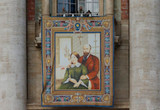The hidden side of St Peter To Rot
By Michael Cook
Originally Published by www.catholicweekly.com.au
Papua New Guinea’s first saint, Peter To Rot, was canonised on 19 October in Rome by Pope Leo XIV.
According to the Catholic Bishops Conference of Papua New Guinea and the Solomon Islands, the new saint is “deeply loved as a model of faith, family life, marriage and courage in witnessing to Christ, especially among the laity. The canonisation will be a moment of immense grace and renewal for the Catholic Church in PNG, the Pacific, and the world.”
In advance of the canonisation, The Catholic Weekly interviewed by email Fr Tomás Ravaioli IVE, an Argentinian missionary who was the vice-postulator, the priest in charge of gathering information about St Peter To Rot for the Vatican.
TCW: Sydney will host the International Eucharistic Congress in 2028. Can you tell us a bit about the new saint’s love for the Eucharist?
Fr Ravaioli: I am personally convinced that the Holy Eucharist was the source of To Rot’s strength. His relationship with the Eucharist began at a very young age.
It is said that he asked to leave his parents’ home when he was just six or seven years old to move in with an uncle who lived closer to the church. He did this because he wanted to participate in daily Mass. And so, he received his First Communion at eight years old, when the normal age was 10 or 11.
His parish priest granted him this privilege, seeing his great devotion.
It is also said that, as a child, during school breaks he would visit the Blessed Sacrament, and it was common to see him kneeling alone, in silence, adoring Jesus. And as he grew older, that love matured, to the point that he continued to receive Jesus daily and spent long periods of time with him in church.

During the war, when the missionaries were in prison, To Rot would walk five or six hours hidden in the jungle, risking his life (because the Japanese prohibited any type of religious activity) to go to the prison and receive the consecrated hosts from them, which he then distributed among the faithful.
And during the period of persecution, he hid the Blessed Sacrament in a grotto, where he frequently went to worship it. His greatest concern was that this hiding place not be discovered, because there lay his treasure.
TCW: He was a martyr for Christian marriage, wasn’t he? What is his message for PNG and for Australia in 2025?
Fr Ravaioli: To Rot died like John the Baptist: defending God’s plan for marriage and family, and telling others what John told Herod: “It is not lawful for you to have your brother’s wife” (Mark 6:18).
In this regard, To Rot teaches us two fundamental things.
First, that God’s plan for marriage and family is one man and one woman, united by a sacrament, until death do them part. Today, the image of the family is deeply distorted and constantly under attack.
The modern world calls any kind of union “marriage” or “family,” and values such as fidelity, unity, and indissolubility are ridiculed and practically non-existent. To Rot reminds us what God intends for marriage and family.
Second, that we are all called to holiness. Holiness is not reserved for a “privileged” few, but we can be holy in whatever state of life we find ourselves.
To Rot was not a bishop, a priest, or a missionary, much less a Doctor of the Church. He was a young man (he married at 24 and died at 33), a married man, a loving husband, and a father of three children.

Therefore, it is necessary to seek holiness in whatever state we find ourselves, whether in the family and within the home, as religious, as celibate, or whatever.
Holiness is not an unattainable luxury, but rather our ultimate goal toward which we must strive with all our strength.
The Catholic Weekly: I gather that the cause of canonisation was held up because it got lost in the Vatican bureaucracy. Thanks for rescuing it! Are there other ‘unknown’ saints who need to be set on a lampstand in PNG?
Fr Tomás Ravaioli: The problem with To Rot’s cause was that those who carried it forward in the 1980s (which culminated in his beatification in 1995) were missionaries who, like me, were foreigners.
When they left the mission in PNG, everyone here thought someone was still in charge of the cause, but that wasn’t the case.
In PNG, we thought someone in Rome was working, and in Rome, they thought we were. It was a miscommunication between us.
That problem was resolved in 2020, when I travelled to Rome to learn about the status of the Cause and learned about this situation.
PNG has many martyrs who, like To Rot, have shed their blood bearing witness to Christ.
There are many missionaries and lay people whose lives deserve to be known.
Narrow Gate Blog
Q&A with Fr Flader: Who was St Jude, the Apostle?
Originally Published by Catholicweekly.com On 28 October each year, the church celebrates the feast...
SmartLoving: Martyrs for marriage through the ages
Originally Published by www.catholicweekly.com.au By Francine and Byron Pirola While couple saints...
The hidden side of St Peter To Rot
By Michael Cook Originally Published by www.catholicweekly.com.au Papua New Guinea’s first saint, P...
Q&A with Fr Flader: Who is St Ava?
Originally Published by www.catholicweekly.com.au QUESTION: My daughter Ava asked me the other day w...
A martyr for marriage: the heroic Peter To Rot, PNG’s first saint
By Michael Cook Originally published by catholicweekly.com.au It’s not the eyes that draw you...
Q&A with Fr Flader: Divorce and children
By Fr John Flader | Originally Published by www.catholicweekly.com.au A couple sitting through ther...







